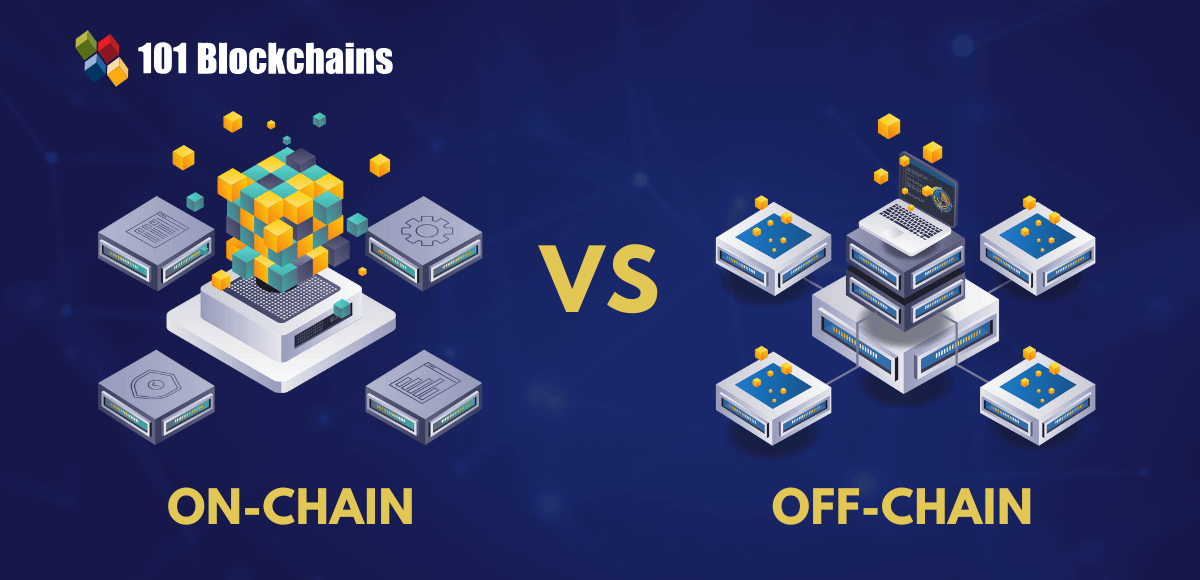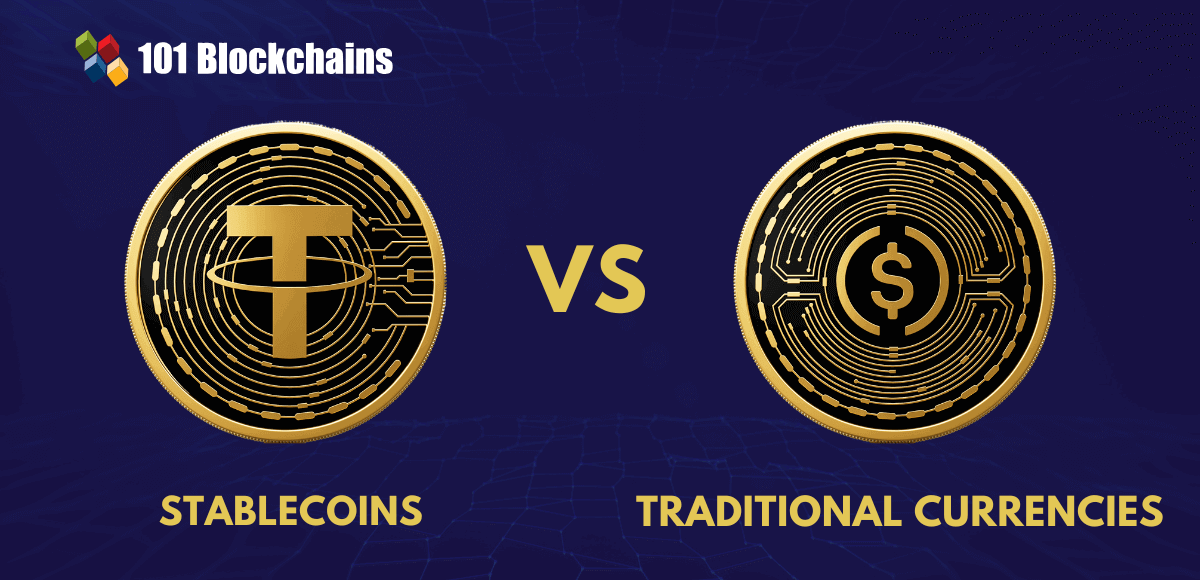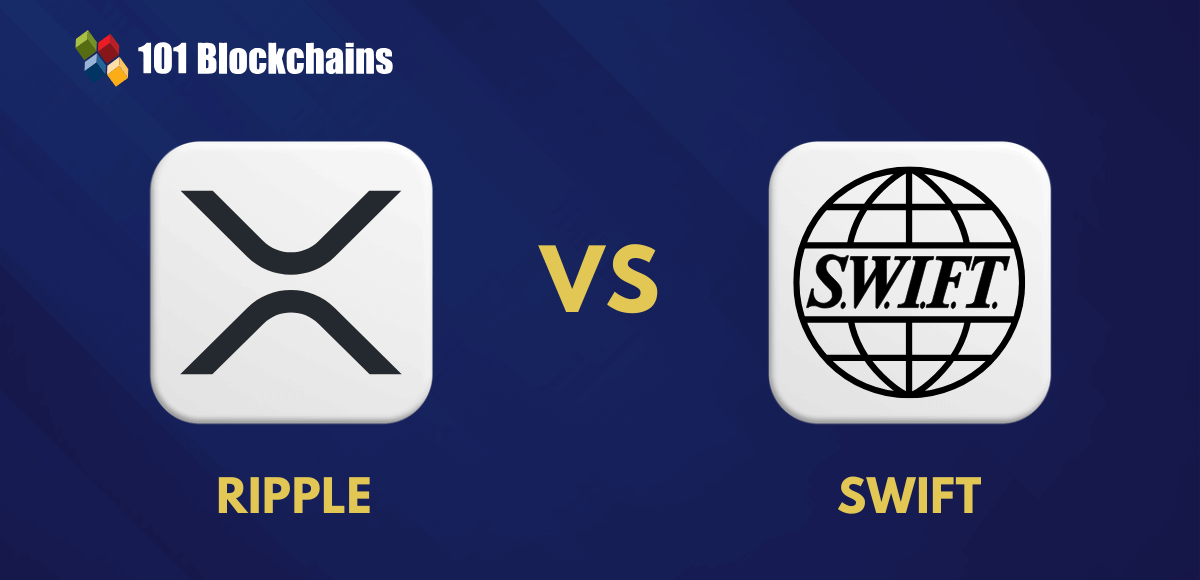Learn how blockchain truly works, master key definitions, and uncover what makes smart contracts so "smart." Dive into the fundamentals, gain valuable insights, and start your blockchain journey today!
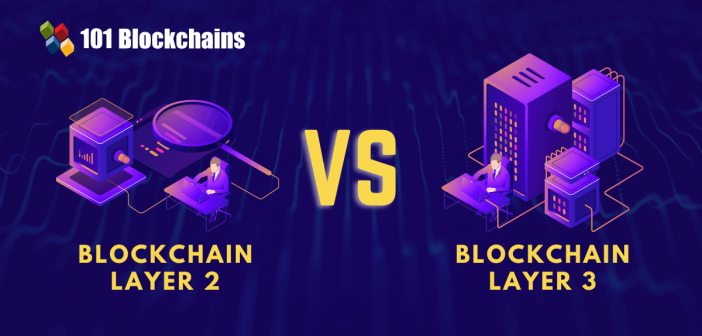
- Comparisons
James Howell
- on December 30, 2022
Blockchain Layer 2 vs Layer 3 – Key Differences
The fast pace of growth in any technology would imply that it will attract more users and serve diverse applications. Blockchain is one of the prominent examples of such technologies, which has achieved significant traction in recent times. As more users populate blockchain-based applications, the layer 1 blockchain networks are struggling to keep up with the need for scalability.
How is the blockchain layer 2 vs layer 3 comparison relevant in this case? Layer 2 solutions offer the benefit of faster transactions by moving transactions to off-chain networks. However, they don’t offer interoperability which has been addressed by layer 3 solutions. Now, it is crucial to reflect on the two options for scaling blockchain transactions as the web3 ecosystem continues expanding.
Layer 1 blockchains are the fundamental blocks of the web3 ecosystem, albeit without the capabilities for scaling on their own. In this case, layer 2 blockchain networks could help reduce transaction fees and latency by reducing congestion on layer 1 blockchains. The layer 2 vs layer 3 blockchain difference comes into play as layer 2 networks cannot enable cross-chain communication.
Therefore, some of the notable DeFi protocols rely on layer 3 networks and applications on protocols for offering cross-chain interoperability. Which one is the better option between layer-2 and layer-3 blockchain networks? The following discussion offers a detailed overview of the evolution of layer 2 and layer 3 networks and their differences.
Build your identity as a certified blockchain expert with 101 Blockchains’ Blockchain Certifications designed to provide enhanced career prospects.
What are Layer 1 Blockchains?
Prior to an overview of the difference between layer 2 and layer 3 blockchain, it is important to understand layer 1 blockchains. In the case of blockchain, layer 1 refers to the base layer of a blockchain network. Some of the common examples of layer 1 blockchains include Bitcoin, BSC Chain, Ethereum, and Cardano. Layer 1 blockchain networks offer the foundation infrastructure for developing dApps.
In addition, developers can create layers for transaction settlement and validation for smart contracts, dApps, as well as other blockchain layers. Another significant highlight of layer 1 blockchains is that they don’t depend on any other network. In addition, layer 1 networks are responsible for the security and consensus implications for dApps and layer 2 solutions developed on the network. Developers could also use layer 1 networks to create other protocols over them without the need for creating another blockchain or native tokens.
Want to become a bitcoin expert? Enroll Now in Getting Started with Bitcoin Technology course!
Why is Layer 1 Inefficient?
The discussion on “What is the best layer blockchain?” starts off with the problems evident in layer 1 networks. Legacy blockchain networks experience a formidable setback in scalability as they struggle to cope with rising demands in the web3 landscape. Blockchain can become a favorable alternative for facilitating everyday payments only if it can process transactions faster than traditional payment service providers. As of now, most of the legacy blockchains cannot compete against payment service providers without any support. In addition, some of the popular blockchain networks, like Bitcoin, have shown setbacks in speed inherently due to their design.
The successful scaling of blockchain technology could help in accommodating more transactions for processing. Questions like “Is layer- 2 or 3 better?” primarily focus on problems of scalability. At the same time, it is also important to identify the factors which affect the direct scalability of layer 1 blockchains.
If you increase the transaction throughput of a layer 1 blockchain, it would most likely reduce decentralization and security. You can understand the reasons behind such an outcome with a description of the ‘blockchain trilemma.’ The phenomenon suggests that blockchain networks have to compromise on decentralization and security as trade-offs for achieving higher performance through scalability.
You should also notice another prominent issue associated with layer 1 blockchain networks which affects scalability. Most of the layer 1 blockchain networks utilize copious quantities of computational resources. The search for relevant answers to “What is the difference between layer 2 and layer 3 blockchain?” would focus on how layer 1 blockchain networks use Proof of Work mining. Proof of Work has been considered one of the most secure approaches for mining, albeit with robust infrastructure and decentralization in the network. However, scaling layer 1 blockchains using Proof of Work mining can be difficult due to the need for additional computing resources.
Solutions for Layer 1 Scaling
An increase in the transaction throughput for layer 1 networks generally result in network congestion, leading to various negative circumstances. The circumstances primarily include slower transaction speeds and increased transaction fees. Subsequently, the layer 1 network encounters prominent drops in its performance. However, you can find many scaling solutions for optimizing layer 1 networks. The blockchain layer 2 vs layer 3 debate should also account for the basic improvements in layer 1 networks for improving scalability.
Developers focus on increasing the TPS or transactions per second processed by the blockchain network. A common approach for increasing TPS involves the expansion of the block size of the network. With the bigger block size, blockchain networks could accommodate more transactions in every block. In addition, a change in consensus mechanism could also offer considerable support in the efficient scaling of blockchain networks.
Another solution adopted for layer 1 network scaling refers to sharding mechanisms, in which developers can partition the blockchain data into different groups to achieve better transaction throughput. The shards are responsible for distinct subsets in the network activity, referred to as ‘city,’ working with varying degrees of transaction complexity. Sharding mechanisms help in reducing the cost, and increasing performance as nodes do not store the whole copy of the blockchain. Shards work by relaying the state of their data to the main blockchain network for validating transactions.
The evaluation of layer 2 vs layer 3 blockchain differences must also account for forking. In some cases, the community of a layer 1 blockchain may disagree on the scalability of the network. Subsequently, it results in the creation of forks in the codebase underlying the layer 1 blockchain. The Bitcoin Cash fork offers a clear sign of division in the Bitcoin community due to disagreements on block sizes. However, the Bitcoin community introduced the segregated witness or SegWit update, which helps in processing more transactions while enabling efficient scalability. The SegWit update achieves scalability improvements through the removal of digital signatures in transaction inputs.
Start learning Blockchain with World’s first Blockchain Skill Paths with quality resources tailored by industry experts Now!
Definition of Layer 2 Scaling Solutions
The inefficient solutions for scaling layer 1 networks are generally responsible for setbacks in developing protocols on layer 1. For example, the development of an application on the Bitcoin blockchain with expectations of high performance would be impractical. The difference between layer 2 and layer 3 blockchain could offer a viable solution in such cases.
Layer 2 scaling solutions work on improving the scalability of layer 1 networks by removing transactions from the main blockchain. Subsequently, it can help in reducing congestion alongside improving throughput for blockchain networks. On top of it, certain layer 2 scaling solutions also incorporate the security mechanisms of layer 1 networks. Layer 2 solutions can offer effective answers for problems in the scalability of blockchains without affecting decentralization or security.
Layer 2 networks are a crucial component for the evolution of blockchain and the web3 landscape. They support the initiatives for scaling popular public blockchain networks. One of the notable examples of the practical use of layer 2 solutions refers to the Ethereum blockchain. Ethereum would shift to Proof of Stake consensus for enabling scalability alongside leveraging layer 2 solutions for reducing network congestion. The lower network congestion would result in faster transaction processing, thereby resulting in lower transaction fees and network latency.
You can find a viable response for “What is the difference between layer 2 and layer 3 blockchain?” with reference to the design of layer 2 networks. The name gives out a lot about layer 2 solutions, suggesting that they create secondary blockchain networks over layer 1 networks. It is also important to note that layer 2 solutions may have different approaches for achieving scalability. However, their primary objective focuses on improving the transaction throughput for main chains.
Here is an outline of the notable entries among layer 2 scaling solutions.
-
Bitcoin Lightning Network
The Bitcoin Lightning Network is one of the most popular examples of layer 2 scaling solutions. It has been developed over the Bitcoin blockchain and offers a higher frequency of transactions while ensuring minimal transaction fees. In addition, it ensures faster transaction settlement without any counterparty risks.
Furthermore, Bitcoin Lightning Network also plays a crucial role in reducing congestion on Bitcoin by leveraging bi-directional payment channels. Developed in 2015, the Lightning Network resolves many setbacks of Bitcoin, such as enabling the reversibility of point-of-sale payments.
-
Optimism
The discussion about queries such as “What is the best layer blockchain?” would draw attention toward Optimism, a layer 2 solution. It relies on ‘optimistic rollups‘ for bundling massive volumes of transactions as batches and sending them to the main Ethereum chain for validation.
In addition, transactions on Optimism could offer the assurance of benefits with Ethereum security. At the same time, it also works to ensure faster confirmation times alongside lower fees. Optimism achieves these value advantages due to the need for one transaction fee in every batch of transactions. You can come across two distinct types of rollups, such as ZK-rollups or Zero Knowledge Rollups and optimistic rollups.
ZK-rollups shift the transaction processing tasks away from the main chain for scalability. The ZK-rollups also associate off-chain transaction batches to on-chain rollup contracts to ensure validation. On the contrary, optimistic rollups assume that transactions are inherently valid unless someone proves otherwise.
-
Polygon Network
The next example of layer 2 solutions to find out answers to “Is layer- 2 or 3 better?” would point at the Polygon network. Developed in 2017, the Polygon network serves as a reliable layer 2 scaling solution with the inherent network benefits of the Ethereum blockchain. It features the benefits of interoperability and security, like the Ethereum main chain, alongside ensuring lower transaction fees and improved throughput.
Furthermore, the Polygon network is one of the most popular layer 2 scaling solutions for Ethereum. On top of it, Polygon also houses a flourishing assortment of dApps and a community of developers. Polygon network relies on plasma implementations for shifting transaction processing tasks away from Ethereum’s main chain, thereby enabling scalability.
Another interesting highlight about Polygon refers to the collection of modular building blocks for helping developers create different dApps. Therefore, Polygon serves a vital implication for the layer 2 vs layer 3 blockchain debate with its value-added benefits. How? Polygon network not only offers scalability but also enables efficiency in ensuring faster time to market for decentralized solutions. Polygon also ensures flexibility for developers while reducing fees.
Excited to develop a comprehensive understanding of Polygon? Join the Standard & Premium Plans and get free access to Polygon Fundamentals Course Now!
-
Arbitrum
Another prominent addition among layer 2 scaling solutions would refer to Arbitrum. Developed by Off-chain Labs, Arbitrum offers a popular scaling solution for Ethereum. Interestingly, Arbitrum features three distinct modes such as Arbitrum Rollup, AnyTrust sidechains, and AnyTrust channels.
The mention of Arbitrum in the evaluation of the difference between layer 2 and layer 3 blockchain networks would help in identifying the advantages of layer 2 over layer 3 solutions. Arbitrum follows the same approach as many other layers 2 scaling solutions by taking away computations off the main Ethereum chain to reduce latency and fees. As an enterprise-grade scaling solution, Arbitrum offers significant benefits for the creation of dApps that can scale up effectively.
The advantages of Arbitrum also extend to streamlining the process of smart contract development. Developers could use their time and efforts to make user experiences better as Arbitrum does the heavy lifting. Furthermore, the smart contracts on Arbitrum also have the power of security at par with the main Ethereum network.
Excited to learn the basic and advanced concepts of ethereum technology? Enroll Now in The Complete Ethereum Technology Course
Definition of Layer 3 Networks
The definition of layer 1 and layer 2 networks offers the initial foundation for identifying answers to “What is the difference between layer 2 and layer 3 blockchain?” with clear examples and explanations. Now, it is essential to reflect on the next improvement over layer 2, i.e., layer 3 scaling solutions. If you take a look at the existing web3 landscape, you will find consistent evolution of new apps and solutions.
For example, DeFi protocols and NFTs are inviting more users to the decentralized web ecosystem. Therefore, applications need to be scalable enough to accommodate the growing number of users. Doesn’t a layer 2 solution solve this problem? Yes, it does. However, layer 2 solutions cannot facilitate communication among different protocols.
Users seek interoperable protocols and cross-chain dApps, which could let them move seamlessly throughout the decentralized services landscape. Therefore, layer 3 solutions have emerged as the need of the hour. Layer 3 networks are a new application layer over layer 1 and layer 2 networks. The layer 3 networks can improve existing blockchain protocols alongside enabling uninterrupted interoperability between layer-1 and layer-2 networks. Most important of all, layer 3 networks help in interconnecting different aspects of the blockchain and web3 landscape to enable communications between them.
The quest for answers to “What is the best layer blockchain?” finds clarity in the advantages of layer-2 networks. The majority of the layer 1 blockchain networks do not feature the trait of interoperability in their design. Layer 3 networks could help in solving this problem by enabling the uninterrupted transfer of data packets among protocols on various chains. In the application layer, you can find different protocols and services which help in connecting different chains. As a result, layer 3 solutions can improve user experiences on cross-chain applications.
Enroll now in the Blockchain Scalability and Interoperability Mastery Course to learn the skills needed to develop faster, scalable, robust, and interoperable dApps.
Comparison of Layer 2 and Layer 3
The definitions of layer 2 and layer 3 blockchain networks offer a brief glimpse of the potential differences between them. Layer 2 solutions work on reducing network congestion by shifting transactions away from the main chain. At the same time, layer 2 solutions also ensure credible benefits in performance by relaying the transactions to the main chain.
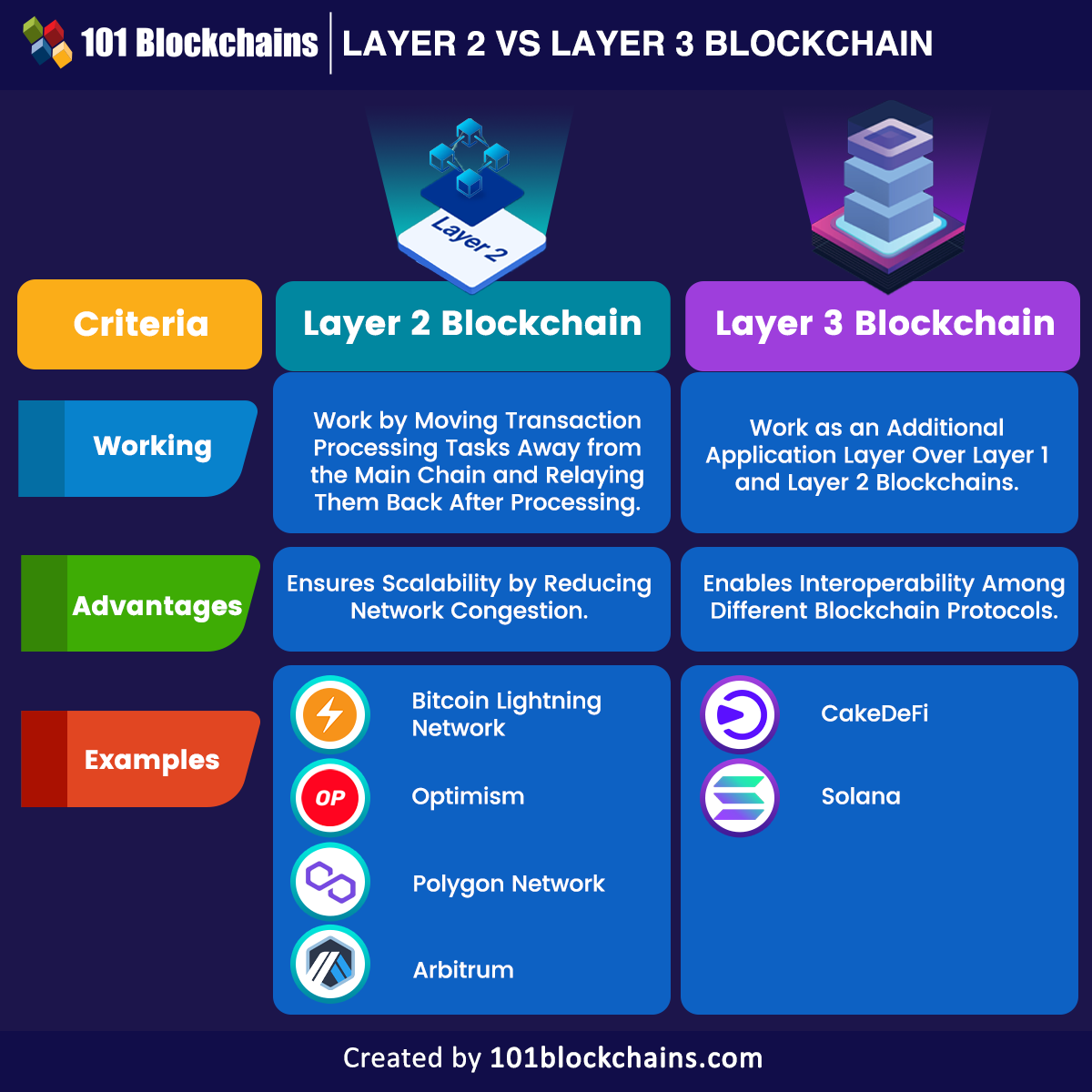
Layer 2 solutions could help in reducing network latency and transaction fees, thereby fuelling prospects for scalability. However, layer 2 networks cannot provide the benefit of interoperability. On the contrary, layer 3 networks can ensure cross-chain communications among multiple protocols. Layer 3 networks could also supplement the communication between layer-1 and layer 2 networks effectively.
Bottom Line
The detailed review of the discussion on layer 2 and layer 3 blockchains suggests that there is no competition between both of them. The answer to “What is the best layer blockchain?” would draw attention to how layer 2 and layer 3 resolve existing setbacks in the web3 landscape. As a matter of fact, layer 2 and layer 3 solutions are crucial for driving mainstream adoption of blockchain technology.
How? Layer 2 can facilitate scalability, which implies lower costs for users along with limited network latency. Subsequently, layer 3 blockchains can enable interoperability among blockchain networks and protocols. Both layer 2 and layer 3 solutions could play a crucial role in empowering the web3 ecosystem with the assurance of better user experiences. Learn more about blockchain technology and how it continues to evolve with new solutions.
*Disclaimer: The article should not be taken as, and is not intended to provide any investment advice. Claims made in this article do not constitute investment advice and should not be taken as such. 101 Blockchains shall not be responsible for any loss sustained by any person who relies on this article. Do your own research!






